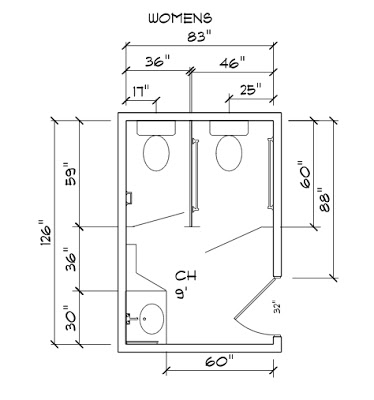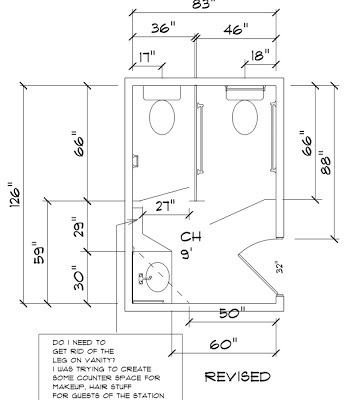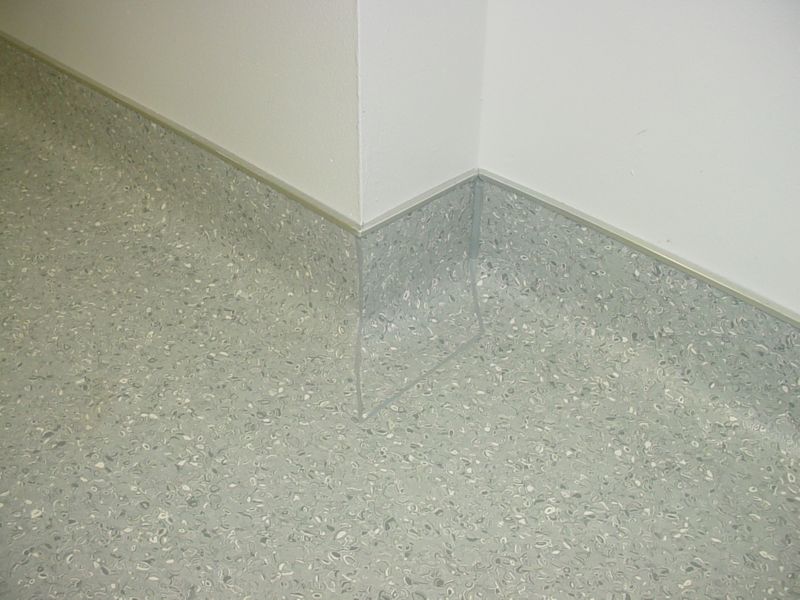For offices undergoing construction, the general assumption is that all bathrooms, whether newly constructed or remodeled, public or common, be usable by people with disabilities.
Tenants who are renovating their space often believe that ONLY public use restrooms are required to be ADA accessible while Common use toilets do not. That assumption is incorrect. ADA rules stipulate each public and common use restrooms shall comply with ADA laws. Public use bathrooms are those that are made available for use by the general public and Common use restrooms are provided for two or more people including offices that do not see the general public.
Other restrooms such as for the sole use by an occupant of a private office shall be made “adaptable”. An adaptable restroom requires clear floor space and minimum door widths. Other items such as grab bars, accessible faucets and plumbing fixtures can be installed later when needed.
Existing bathrooms are not grandfathered by the ADA. Even if alterations are not made, an existing public use restroom must provide for accessible features when feasible.
A change to a building or facility that affects or could affect the usability of the building or facility or portion thereof. Alterations include, but are not limited to, remodeling, renovation, rehabilitation, reconstruction, historic restoration, resurfacing of circulation paths or vehicular ways, changes or rearrangement of the structural parts or elements, and changes or rearrangement in the plan configuration of walls and full-height partitions. Normal maintenance, painting or wallpaper, or changes to mechanical and electrical systems are not alterations unless they affect the usability of the building or facility.
In bathroom alterations, an altered fixture must be made accessible. For instance, if you are replacing a faucet, it must be replaced with an accessible faucet. And altering one item does not necessarily require compliance for existing items.
Even if there are no restroom alterations planned, renovations to the surrounding area served by the restroom may trigger ADA compliance. This is referred to as an alteration to an area containing a primary function. Offices and conference rooms are considered primary function areas. Therefore, if they are altered, the restrooms serving that altered area are required to be made accessible. Hallways, restrooms and break rooms would not be considered primary function areas.
Options for Existing Restrooms and exceptions for achieving compliance include:
- A single accessible unisex restroom can be provided if it is determined that compliance in the existing restrooms is technically infeasible. The unisex restroom must be provided on the same floor and in the same area as the existing inaccessible restrooms.
- In a multi-user restroom, smaller accessible toilet stalls may be allowed if it is technically infeasible to provide the standard accessible stall or if a reduction in fixtures (to provide a double-wide stall) is not permitted by the plumbing code.
It is also permitted to use a single unisex accessible restroom when compliance for the existing restrooms is technically infeasible, but it does not allow the use of the alternate accessible toilet stalls. Technically infeasible is defined as something that has little likelihood of being accomplished because existing structural conditions would require removing or altering a load-bearing member that is an essential part of the structural frame; or because other existing physical or site constraints prohibit modification or addition of elements, spaces, or features that are in full and strict compliance with the minimum requirements.
Where multiple single-user restrooms are clustered at a single location, at least 50 percent but not less than one room for each use at each cluster shall be accessible.
For more information see ADA Standards for Accessible Design
Discover more from Helping NYC & Long Island Commercial Tenants, Owners, and Developers
Subscribe to get the latest posts sent to your email.








In co-op in palm Beach FLa when ADA a
Was asked if remodeling changing all light fixtures from fluorescent to barrel lights & bathroom toilets & wash basins & one urinal that two bathrooms adjacent to the lobby would not have to compliant to ADA requirements if not used for general public only for guests of redsidence, residents ,employees and contractors/ vendors visiting manager office . However where there is public event accommodation would have to be made to accommodate the requirements of ADA. Please advise if you agree perhaps I did not understand.
Thank you for your question, Ronald.
I am neither a code compliance officer, expeditor or schooled in residential MDU construction. What I can suggest is ADA compliance requirements may vary from AHJ to AHJ. We’re regularly beholden to the plan examiner’s education and requirements are often inconsistent from one DOB to another.
I have an issue currently at an industrial facility in Suffolk County, NY where we are performing cosmetic upgrades to a toilet room – swapping out a 30-year-old vanity, toilet, metal partition, and new ceramic tile. We didn’t think ADA was triggered because it’s an internal toilet room for employees and we aren’t changing design, size, or layout.
The local AHJ objected and stated “Even for just “cosmetic updates” each bathroom must contain a handicap accessible toilet. Your clearances around the toilets do not meet code 604.3.1 in the ICC A117.1-2009.” They required us to either construct an accessible toilet room nearby or convert the existing toilet room to gender-neutral to conform to ADA. We have two restrooms and fixture counts sufficed.
Our architect and expeditor challenged the plan examiner stating cosmetic upgrades do not trigger ADA compliance. We also inquired with a neighboring AHJ if they would have required ADA compliance and we were told no. However, this examiner refused to budge and would not stamp the drawings nor would provide a CO without conforming to his wishes.
At the end of the day, the examiner is King and each AHJ may interpret the code differently. If you haven’t already done so, contact an expeditor or consult with the Palm Beach County Planning, Zoning & Building Department’s Code Compliance Division. They are going to be your best resource.
If an existing accessible unisex single commode was converted to shower, not only would the shower have to be accessible but the existing mens and womens rooms nearby would have to be made accessible? Even if there is an accessible path of travel to another accessible mens and womens bathroom?
I have a warehousing facility in CA and have a private office as the owner of the business. I added a shower in an existing restroom back in 2005 or so……no permits were filed with the City. This is a PRIVATE Restroom and not available to my employees or anyone else. The local Fire & Building Safety people are telling I must make this restroom ADA compliant and then offer showers to all my employees with ADA even though my employees are not required to shower for their jobs. This seems crazy to me that I cannot have a private office with a private restroom and shower for my use only. What’s my leverage to get out of this? Thank you! Brad~
Do you own this building? This bathroom is only for your use an at no time did you intend to offer its use to anyone who works for or with you? As the only access is through your office. If so I would discuss with a local Real Estate licensed and an architect. If you answered yes to all of these points then it would seem herein is your argument. Not accessible to anyone but you.
Just think of this as a best practice, look at the numbers at least, to build a ADA restroom from scratch is approximately $7K to $9K, look at the economics and I am very sure you would see, if your already doing a renovation of the common area hallways it make sense, one of the first places I look to see that they are not scrimping on is the restrooms. During visual inspections, I look to see how the restrooms are kept, if they are spotless, then you pretty much know you have people on the job and a management team, that share a pride in management. On the other hand if you go to a restaurant and see a bathroom that is not spotless, leave, as the means they don’t care how the front of house is presented so beware the back of house. I have left restaurants after I have sat down and get up to wash my hands.
Dear Richard
Reading thru the email threads brings me to my question. it’s about accessible toilets. My client has a large warehouse built in 2 stages. the original building is 4000 sf and the addition is 16000 sf. the adjoining wall is a 4hr wall. the primary function for the entire warehouse was once Haz Waste Storage. The one toilet (sink and wc) is solely associted with the 4000 sf area. He wants to change the primary function of the 16000 sf portion from haz storage to a simple warehouse function, absolutly no haz storage, at all. There will be a rated coiling door between the two areas. does this trigger upgrading the non-compliant toilet.
Curtis, I would tend to err on the side of caution and direct you to a code expert such as Milrose Consultants. See their blog article http://www.milrose.com/newsletter/new-york-code-question-restroom-renovations-and-compliance-with-ll-5887/. This may help guide you. You might also direct your question to infony@milrose.com
Good luck
Hi Richard. I am currently trying to rent an office space that doesn’t require any renovation besides paint and a new industrial carpet. Do I have to bring the bath up to ADA code just because I’m moving in? The landlord says I have to convert.
James, not all renovations will trigger mandatory ADA compliance. My understanding is that you can go as far as updating finishes and fixtures. So long as you do not alter the roughing you’re not required to bring into compliance. Flooring including carpeting may trigger ADA compliance because it may affect how an individual travels in a wheelchair and has to meet the rules for carpeting and non-slip surfaces. For your specific situation, I would consult an architect, expeditor or code official.
Below is a section from the ADA Guidelines
§36.402 Alterations.
(b) Alteration. For the purposes of this part, an alteration is a change to a place of public accommodation or a commercial facility that affects or could affect the usability of the building or facility or any part thereof.
(1) Alterations include, but are not limited to, remodeling, renovation, rehabilitation, reconstruction, historic restoration, changes or rearrangement in structural parts or elements, and changes or rearrangement in the plan configuration of walls and full-height partitions. Normal maintenance, reroofing, painting or wallpapering, asbestos removal, or changes to mechanical and electrical systems are not alterations unless they affect the usability of the building or facility.
(2) If existing elements, spaces, or common areas are altered, then each such altered element, space, or area shall comply with the applicable provisions of appendix A to this part.
§36.403 Alterations: Path of travel.
(d) Landlord/tenant: If a tenant is making alterations as defined in § 36.402 that would trigger the requirements of this section, those alterations by the tenant in areas that only the tenant occupies do not trigger a path of travel obligation upon the landlord with respect to areas of the facility under the landlord´s authority, if those areas are not otherwise being altered.
See http://www.ada.gov/regs2010/2010ADAStandards/2010ADAstandards.htm
What is the ADA compliance code for bathrooms in a small pediatric office. There will be no structural changes to the space. All hallways and doors are already compliant. The restroom does have grab bars. The previous doctor in the office was in a wheel chair.
Thanks for the insights on this Richard!
Best,
David Thomas
The ADA does not require that the building be made non-complaint with another code to provide barrier free facilities. for instance if you have a landlocked toilet room, there is an exception to not be fully compliant if it means reducing the fixture counts to a sub-plumbing code compliance. Other aspects of barrier free access do need to be put in place, such as grab bars, lever handles, etc. This exception is not a total free pass.
Hey Richard,
Great post! It’s amazing how much we don’t know… and how that liability of lack of knowledge can hurt us.
Another important aspect of any renovation is ensuring your IT needs are “Handicap Accessible” as well. Often the need to run cabling in a remodel environment is not properly addressed. It’s a great time of change for an organization and a great time to rethink their IT infrastructure deployment.
Would love to see/collaborate with you on a post along those lines…
Brian C. Andersen
Hosted VoIP Specialist
949.381.0718
Thanks Brian. Handicap accessible IT is not an area I’m familiar with. If you have the time, feel free to address the issue as a contributing columnist. I’d love to post it. It can be 500 words avg and not a self promotion though I always give credit to the author.
Hi Richard,
Love to read your posts! I always feel so much smarter too! Thanks for sharing this information with us all.
Linda
Thank you for the kind words Linda and your continued support.
After a bit of a hiatus due to a busy work schedule (which is a good thing), I have some time to devote to contributing content.
Hope all is well
Yeah! Glad to have you back, but glad you were busy too!